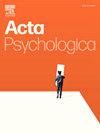Improvement by imagining actions: Bimanual transfer effects after action imagery practice in a sequential reaction time task
IF 2.1
4区 心理学
Q2 PSYCHOLOGY, EXPERIMENTAL
引用次数: 0
Abstract
Action-imagery-practice refers to the repetitive use of action imagery to improve subsequent performance leading to partially different representation types than action-execution-practice (AEP). This study explored the representation types in kinesthetic action-imagery-practice (K-AIP) and visual action-imagery-practice (V-AIP) in a serial reaction time task using the crossed hand transfer paradigm. 169 participants (age M ± SD = 25.2 ± 3.9) were randomly assigned to AEP, K-AIP, V-AIP, or control-practice (CP), practicing with uncrossed hands on ten consecutive days. Tests involved the same sequence, a mirror sequence, a shifted sequence, and a shifted mirror sequence, each with uncrossed and crossed hands. With crossed hands, sequence-specific transfer effects indicated only little evidence for effector-independent representations in late stages of learning in AEP and V-AIP. Performance in the same sequence with uncrossed hands indicated the acquisition of stimulus-response location associated effector-dependent sequence-specific representations in AEP, K-AIP and V-AIP, but not in CP. These visual-spatial effector-dependent representations were stronger after AEP than after AIP. Overall, no important differences between both AIP groups were observed, and both groups reported similar focus on kinesthesis and vision, suggesting that irrespective of the instructions, rather than focusing on one single modality, AIP always involves a combination of both modalities - vision and kinesthesis - that promote motor learning.
通过想象动作提高能力:在连续反应时间任务中进行动作想象练习后的双臂转移效应。
动作-意象-练习是指重复使用动作意象来提高随后的表现,导致与动作-执行-练习(AEP)部分不同的表现类型。本研究采用交叉手迁移范式,探讨了系列反应时任务中动觉动作-意象练习(K-AIP)和视觉动作-意象练习(V-AIP)的表征类型。169名参与者(年龄M±SD = 25.2±3.9)被随机分配到AEP、K-AIP、V-AIP或对照练习(CP)组,连续10天不交叉双手练习。测试涉及相同的序列,镜像序列,移位序列和移位镜像序列,每个序列都有未交叉和交叉的手。双手交叉时,序列特异性迁移效应在AEP和V-AIP学习的后期阶段仅显示出少量与效应无关的表征。在相同的动作序列中,手未交叉的表现表明在AEP、K-AIP和V-AIP中获得刺激-反应位置相关的效应依赖序列特异性表征,而在CP中没有。这些视觉空间效应依赖表征在AEP后比AIP后更强。总的来说,两个AIP组之间没有观察到重要的差异,两组都报告了对动觉和视觉的相似关注,这表明不管指令如何,AIP总是涉及两种模式的结合-视觉和动觉-促进运动学习。
本文章由计算机程序翻译,如有差异,请以英文原文为准。
求助全文
约1分钟内获得全文
求助全文
来源期刊

Acta Psychologica
PSYCHOLOGY, EXPERIMENTAL-
CiteScore
3.00
自引率
5.60%
发文量
274
审稿时长
36 weeks
期刊介绍:
Acta Psychologica publishes original articles and extended reviews on selected books in any area of experimental psychology. The focus of the Journal is on empirical studies and evaluative review articles that increase the theoretical understanding of human capabilities.
 求助内容:
求助内容: 应助结果提醒方式:
应助结果提醒方式:


